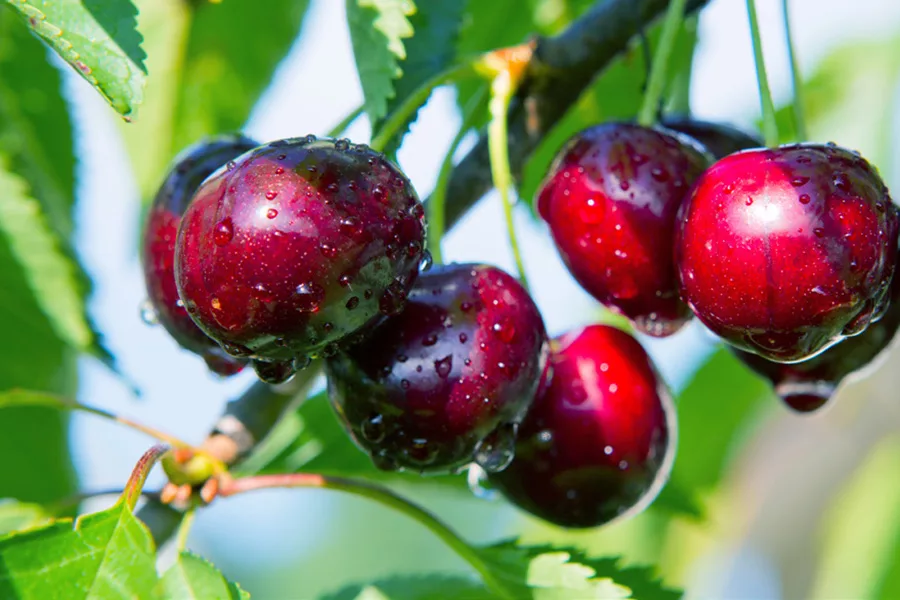
Home » Forecast looks rosy for state’s cherry farmers
Ready to shine
Forecast looks rosy for state’s cherry farmers

A combination of marketing factors and a large crop are contributing to a feeling of optimism about this year’s cherry industry.
June 12, 2025
A large crop and favorable market conditions promise a good year for Northwest cherries.
As of mid-May, the five-state Northwest region of Washington, Oregon, Idaho, Montana and Utah was expecting to see a cherry crop of 21.4 million 20-pound boxes this summer, with the first cherries set to be picked in early June.
That estimate would be a 9% increase over 2024’s 19.5 million-box crop, but it’s not just the predicted size that’s contributing to a feeling of optimism about this year’s cherries.
A forecasted small crop from California could help with our state’s market conditions.
California’s cherry season starts earlier than the Northwest’s, and an overlap between the two can make selling cherries more difficult – which is what happened in 2023, when the Northwest’s cherries ripened earlier than usual, compressing the season into a shorter time frame.
That’s because cherries are a perishable crop and can’t be stored like apples or pears, said Jon DeVaney, president of the Washington State Tree Fruit Association. “A short interruption in the market momentum can be very disruptive to cherry growers and the sales of cherries,” he said. “The exact timing and maintaining market momentum is really important for cherry growers.”
This year, California is projected to produce about 5 million 20-pound boxes of cherries, down from last year’s 9 million. That will give the Northwest’s crop plenty of room to shine.
Although the Northwest cherry region consists of five states, Washington is the No. 1 sweet cherry-producing state in the U.S.
The growing conditions have been good so far this year, though one windstorm or rainstorm could affect the season’s start date.
To market
Washington’s cherries ranked No. 9 among ag exports in 2024 with a crop valued at $292.3 million, an increase of more than 23% over the previous year.
About 30% of the Northwest’s cherries are sold outside of the U.S., and Canada, South Korea and Taiwan are the top export markets for the state’s sweet cherries. China was the No. 4 export market for Washington cherries in 2024, according to data compiled by the Washington State Department of Agriculture.
Ongoing trade discussions at the federal level have the potential to positively benefit the cherry industry, DeVaney said, and growers are optimistic.
“Seeing an initial framework agreement in the United Kingdom is a good indication that some of those agreements are underway and may be soon bearing fruit, if you will,” DeVaney said. Several organizations in the ag industry work to track those issues and influence policy makers, he said.
The U.K. has been an important market in the past, but non-tariff trade barriers have limited the ability to export products there, DeVaney said. Opening negotiations may allow the U.S. to export more products to the U.K. Regulations regarding pesticides can lead to long regulatory processes, especially as new products come out and are adopted by growers.
While trade policy remains uncertain, a 90-day suspension of retaliatory tariffs between the U.S. and China implemented in May could boost cherry exports during their peak season.
“The rollback of retaliatory tariffs by China and the U.S. for 90 days of negotiations makes cherry exports to China, a significant market, more viable than they would have been with rates well above 100%,” DeVaney said in a late-May email to the Tri-Cities Area Journal of Business.

Washington is the No. 1 producer of sweet cherries in the U.S., and about 30% of the cherries harvested in the Northwest are exported.
Labor challenges
Labor costs and availability continue to be a challenge in the industry, especially because the perishability of cherries means the fruit must be picked within a narrow window.
Some growers have scaled back their production, DeVaney said, which has helped reduce the labor shortage. It’s not good news for the industry as a whole, but for the growers still surviving, it can be beneficial.
Costs continue to be high, with “a rapid escalation in the mandated minimum wage costs” for temporary federal H-2A workers and the relatively recent overtime pay requirements Washington has implemented, DeVaney said.
Washington’s Adverse Effect Wage Rate for H-2A workers is $19.82, one of the highest rates in the country. And the state’s overtime pay requirements, put into place in 2024, mean that growers have to pay time-and-a-half for every hour worked over 40 hours a week. That can be challenging for growers, and may mean that some growers choose not to harvest their crops if they can’t afford the overtime pay.
To help manage those difficulties, growers put thought into diversifying their acreage and managing their workforce – but despite all the growers’ planning, nature can still throw curveballs.
“If those conditions require changing your work schedule, it could potentially mean costs that you can’t recoup,” he said.
One positive that growers will see this year is the ag fuels bill that Gov. Bob Ferguson signed in May in Kennewick. House Bill 1912 helps clarify how growers can be exempted from fuel surcharges under the Climate Commitment Act. The act went into effect in January 2023, and though agricultural operations should have been exempt, many producers were charged anyway.
The new bill “not only clarifies for growers where they can access suppliers that will provide the exemption, but also extends some of those exemptions for another two years,” DeVaney said.
Cherry benefits
DeVaney also noted that national discussions around eating more healthy food help to boost the cherry industry. That’s because the industry focuses on selling whole, fresh foods to consumers, he said.
Cherry health benefits can include phenolic compounds in dark sweet cherries that may reduce the risk of breast cancer by inhibiting cancer cell growth; anti-inflammatory properties that can reduce chronic inflammation or support a healthier gut biome; and cherries can serve as a prebiotic food to support a healthy gut, according to a fact sheet from Northwest Cherries. Cherries also are hydrating and a good source of fiber.
The focus on eating healthy is “an encouraging social trend,” DeVaney said. “For so long we’ve been in competition with a lot of processed products and so seeing national attention to a focus on health should benefit growers of fresh fruits that are known for their health benefits.”
Agriculture + Viticulture
Related Articles
Related Products





